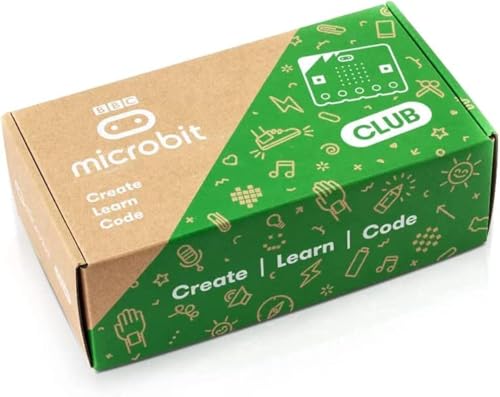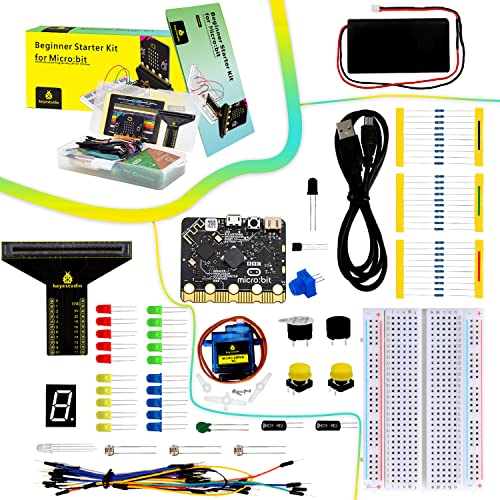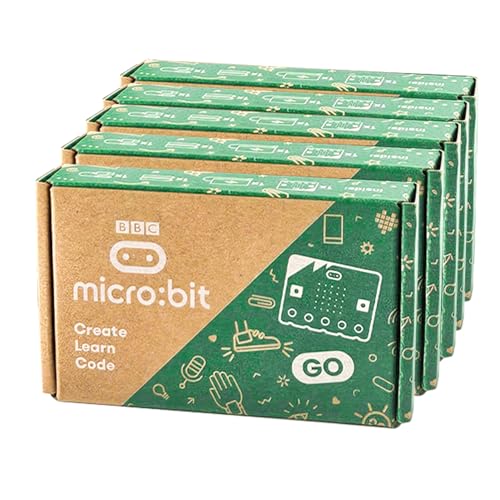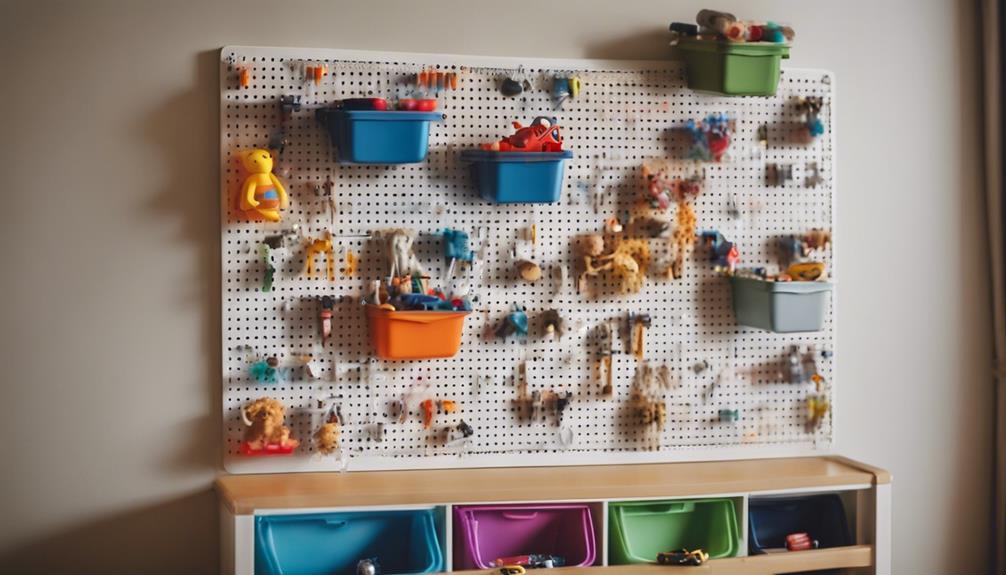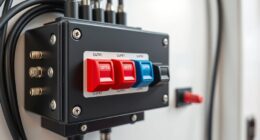If you’re looking to inspire young innovators in 2025, I recommend exploring the top micro:bit classroom kits like the BBC micro:bit v2 Club Pack, ELECFREAKS Nezha Inventor Kit, Yahboom Robotics Kit, and others that promote hands-on STEM learning. These kits offer a variety of components, easy assembly, and engaging projects to spark creativity and problem-solving. Keep exploring further to discover how each kit can unleash fresh ideas and skills in your students.
Key Takeaways
- Top kits feature comprehensive components like sensors, motors, and expansion boards to support diverse STEM projects and creativity.
- Many kits include detailed tutorials, lesson plans, and online resources to enhance classroom engagement and ease of use.
- Advanced options incorporate AI, wireless communication, and programmable robots to foster innovation and technical skills.
- Kits are designed for various age groups, promoting collaborative learning and hands-on experimentation for young innovators.
- Some popular brands offer modular, durable, and easy-to-assemble kits suitable for classroom, club, and home STEM activities.
KEYESTUDIO Micro:bit Smart House Kit for Micro:bit V2 (Not Included)
If you’re looking for an engaging way to introduce students or beginners to home automation and IoT concepts, the KEYESTUDIO Micro:bit Smart House Kit is an excellent choice—especially since it offers hands-on experience in building and programming smart features. This kit includes a paintable wooden house with sensors, an LCD display, motors, RGB LEDs, and more, enabling users to create projects like sound-controlled lights, password-protected doors, and motion detection. Designed for easy assembly with clear tutorials, it promotes creativity through painting and building while teaching electronics and coding fundamentals. It’s perfect for classrooms, clubs, or home learning, inspiring young innovators to explore IoT concepts practically.
Best For: beginners, students, and educators interested in hands-on learning of home automation, electronics, and IoT concepts through DIY projects.
Pros:
- Promotes creativity with painting and assembling wooden house components.
- Provides comprehensive tutorials suitable for beginners and classroom settings.
- Enables practical understanding of sensors, actuators, and programming in home automation.
Cons:
- Micro:bit V2 board and batteries are sold separately, adding to the overall cost.
- Not suitable for real house automation, limited to educational and demonstration purposes.
- Customer reviews rate the kit as average (3 out of 5 stars), indicating varying user experiences.
ELECFREAKS microbit Ring:bit 6-in-1 Building Bricks Kit
The ELECFREAKS microbit Ring:bit 6-in-1 Building Bricks Kit stands out as an excellent choice for teenagers and young adults enthusiastic to explore coding and robotics through hands-on projects. It includes a versatile Ring:bit expansion board that adds GPIO ports and powers accessories with batteries, along with nearly 200 compatible building bricks. The kit allows you to build six main models, such as traffic lights, cars, and fans, making learning engaging. While some bricks are lower quality, the high-quality servos and detailed instructions enhance the experience. Overall, this kit encourages creativity, coding skills, and practical understanding of robotics in a fun, accessible way.
Best For: teenagers and young adults interested in exploring coding, robotics, and hands-on building projects with a versatile, educational kit.
Pros:
- Includes nearly 200 compatible building bricks for versatile construction and creativity.
- Supports building six main models, making learning engaging and varied.
- Provides detailed assembly instructions and courses, facilitating easier learning and project completion.
Cons:
- Some bricks are of lower quality, with cheaper plastic and occasional pre-breakage.
- Building instructions for specific projects can be sparse or hard to find online.
- Does not include a micro:bit, so users must supply their own device to operate the kit.
Yahboom Microbit V2 Coding Robotics Kit for Kids
Designed specifically for young learners and educators, the Yahboom Microbit V2 Coding Robotics Kit for Kids offers an engaging way to explore robotics and coding. It combines the Micro:bit microcomputer with sensors, LEDs, and programmable buttons, making it perfect for STEM education. The kit includes a robot car that supports obstacle avoidance, light detection, and music playback, encouraging hands-on learning through game-based challenges. Assembly is simple, with clear instructions and safety features like reverse connection prevention. Supporting drag-and-drop programming and Python, it caters to all skill levels, helping kids develop creativity, logical thinking, and technical skills confidently.
Best For: young learners, educators, and parents seeking an engaging, beginner-friendly robotics and coding kit to develop STEM skills through hands-on projects and interactive programming.
Pros:
- Supports multiple programming methods including drag-and-drop and Python, catering to different skill levels.
- Includes a versatile robot car with various sensors and expansion options for creative customization.
- Comes with comprehensive instructions, safety features, and online support to facilitate easy assembly and learning.
Cons:
- May require additional components or tools for advanced modifications not included in the kit.
- The complexity of some features might be challenging for very young children without adult supervision.
- Limited to basic robotics functions unless expanded with extra modules or accessories.
BBC micro:bit v2 Club Pack (10x)
Looking for a versatile classroom kit that sparks creativity and hands-on learning? The BBC micro:bit v2 Club Pack (10x) delivers exactly that. It includes ten compact micro:bit v2 boards, each with an onboard speaker, microphone, and sensors for immersive audio and sensor-based projects. Designed to support AI and machine learning exploration, these devices are compatible with existing lessons, making integration seamless. The pack comes with USB cables, battery holders, and plenty of batteries, enabling multiple projects. With positive reviews and a high rating, this kit offers an affordable, portable, and engaging way to inspire young innovators in any classroom setting.
Best For: educators and students seeking an affordable, versatile classroom kit for hands-on coding, electronics, and sensor-based projects with built-in audio and AI exploration capabilities.
Pros:
- Includes 10 micro:bit v2 boards with built-in speaker and microphone for multimedia projects
- Supports AI and machine learning exploration with enhanced hardware features
- Comes with comprehensive accessories like USB cables, battery holders, and batteries for multiple setups
Cons:
- Slightly larger and heavier compared to previous micro:bit models, which may affect portability for some users
- Requires batteries for operation, adding ongoing costs and logistical considerations
- Limited to classroom and educational use, which might restrict advanced hobbyist applications
GeeekPi microbit V2 Club Kit (10 Pack microbit v2 go kit)
Are you searching for a versatile kit to support multiple students in STEM projects? The GeeekPi microbit V2 Club Kit offers 10 upgraded micro:bit V2 boards with powerful processors, built-in speaker, and microphone for audio projects. Each unit includes sensors for environmental data, Bluetooth and radio for wireless communication, and programmable LEDs. The kit comes with 10 micro USB cables, battery holders, AAA batteries, and user guides, making it ideal for classroom use. Its robust features promote coding, robotics, and innovative experiments. Lightweight and compact, this kit ensures students can easily explore and create, inspiring the next generation of young inventors.
Best For: educators, students, and hobbyists seeking a comprehensive STEM kit to facilitate coding, robotics, and environmental projects with multiple micro:bit V2 units.
Pros:
- Includes 10 upgraded micro:bit V2 boards with powerful processors and integrated audio features
- Comes with essential accessories such as USB cables, battery holders, and batteries for ready-to-use classroom setup
- Supports wireless communication and a variety of sensors, ideal for diverse programming and experimentation
Cons:
- Bulkier setup due to multiple units, which may require more storage space
- May be more expensive compared to single-unit micro:bit kits
- Limited to the included accessories; additional components may be needed for advanced projects
KEYESTUDIO Microbit Basic Starter Kit for BBC Micro:bit V2
The KEYESTUDIO Microbit Basic Starter Kit for BBC Micro:bit V2 is an excellent choice for beginners, educators, and hobbyists looking to jumpstart their coding and electronics projects. It includes the Micro:bit V2.21 controller, featuring Bluetooth, an accelerometer, electronic compass, and a 5×5 LED matrix. The kit offers organized components like resistors, sensors, LEDs, and a display, supporting at least 18 projects. All parts are tested and well-packed, making it easy to start experimenting immediately. The all-encompassing manual and online tutorials help users build confidence, making this kit ideal for hands-on learning, classroom activities, and fostering young innovator skills.
Best For: beginners, educators, and hobbyists seeking an all-in-one kit to learn coding and electronics with the BBC Micro:bit V2.
Pros:
- Organized components with individual packaging for easy access and storage
- Includes comprehensive manual and online tutorials to support learning
- High-quality, tested parts suitable for various projects and skill levels
Cons:
- Some users find the instructions and manual snippets unclear or small in size
- Wiring issues such as breadboard connections falling off may occur
- Limited detailed project guidance within the manual, requiring supplementary online resources
7 Bulk STEM Kits for Kids Aged 8-12
For educators and parents seeking affordable, engaging STEM activities, bulk sets of kits designed for kids aged 8-12 offer an excellent solution. These kits include components like motors, red fan blades, battery holders, and green bases, all packaged individually for easy gifting or storage. They require no screws and are simple to assemble with clear instructions, making them perfect for classroom projects, summer camps, or family activities. Designed to teach basic circuits, electrical engineering, and STEM concepts, they foster hands-on learning, creativity, and problem-solving. These versatile kits encourage teamwork and curiosity, making STEM education both fun and accessible for young learners.
Best For: educators, parents, and STEM enthusiasts seeking affordable, engaging, and easy-to-assemble science kits for children aged 8-12 to promote hands-on learning and STEM exploration.
Pros:
- Supports STEM learning through practical, build-your-own fan projects.
- No screws needed, making assembly simple and accessible for young learners.
- Packaged individually, ideal for gifting, classroom activities, and group projects.
Cons:
- AA batteries are not included, requiring an additional purchase.
- Limited to basic circuit and electrical concepts; may need supplemental activities for advanced learners.
- Some children may need supervision or assistance with assembly depending on skill level.
ELECFREAKS microbit Mini Cutebot Kit for BBC Micro:bit V2 & V1
If you’re looking for an engaging, beginner-friendly robot kit compatible with both BBC micro:bit V1 and V2, the ELECFREAKS microbit Mini Cutebot Kit is an excellent choice. This compact, adorable robot car comes pre-assembled, requiring only the ultrasonic sensor for immediate use. Designed for ages 7 and up, it offers versatile features like obstacle avoidance, line following, and distance tracking with dual-speed motors. The kit supports graphical programming via MakeCode and advanced coding in Python or microPython. Its extension port allows for custom sensors and modules, making it ideal for fostering creativity, problem-solving, and hands-on STEM learning in classroom or personal projects.
Best For: educators, students, and beginners interested in STEM learning and robotics who want an easy-to-use, programmable robot car compatible with BBC micro:bit V1 and V2.
Pros:
- Easy to assemble and operate, suitable for beginners and young learners
- Supports multiple programming options, including MakeCode, Python, and microPython
- Extensible port allows for customization with additional sensors and modules
Cons:
- Durability issues reported with connection points and parts after frequent use
- Motor sensitivity to battery voltage can affect performance and control
- Lacks included accessories like remote controls and may have higher shipping costs for extras
KEYESTUDIO Micro:bit V2 Go Bundle Kit (5 Pack Microbit V2.2 Go Kit)
Students and educators seeking an all-in-one classroom solution will find the KEYESTUDIO Micro:bit V2 Go Bundle Kit particularly valuable. This bundle includes five micro:bit v2.2 boards with built-in sensors, LEDs, buttons, Bluetooth, and wireless capabilities, making it ideal for diverse STEM projects. The user-friendly drag-and-drop programming editor simplifies coding for beginners, encouraging hands-on learning. The package comes complete with USB cables, battery holders, batteries, and guides, ensuring everything needed to start immediately. With high customer ratings and its focus on education, this kit is perfect for fostering creativity, innovation, and technical skills in young learners.
Best For: educators, students, and beginner STEM enthusiasts seeking an all-in-one, easy-to-use micro:bit kit for classroom projects and hands-on learning.
Pros:
- Includes five micro:bit v2.2 boards with comprehensive sensors and wireless features for versatile projects
- User-friendly drag-and-drop programming editor ideal for beginners and classroom use
- Complete package with USB cables, batteries, and guides, ready for immediate deployment
Cons:
- Limited to educational and STEM-focused applications, not suitable for advanced or commercial projects
- The product is sourced from China, which may affect shipping times and support options in some regions
- As a bundled kit, it may be more expensive than purchasing individual micro:bit boards separately
ELECFREAKS microbit Starter Kit for Kids
The ELECFREAKS microbit Starter Kit for Kids stands out as an excellent choice for beginners enthusiastic to explore electronics and programming. Designed for kids over 10, it offers hands-on learning with 24 components like LEDs, sensors, servos, and motors. While the micro:bit board must be purchased separately, the kit includes 14 project cases and detailed tutorials supporting Makecode, JavaScript, and Python. It makes learning engaging and accessible, enabling kids to create projects such as traffic lights and photocell displays. Rated 4.2 stars, it’s praised for its educational value, variety of parts, and project ideas, making it a fantastic starter kit for young innovators.
Best For: beginners and young learners over 10 years old interested in exploring electronics, coding, and STEM concepts through hands-on projects.
Pros:
- Offers a comprehensive set of 24 components for diverse experiments and projects
- Supports multiple programming languages including Makecode, JavaScript, and Python for flexible learning
- Includes detailed tutorials, manuals, and online resources to facilitate easy understanding and troubleshooting
Cons:
- Micro:bit board must be purchased separately, adding to overall cost
- Limited to ages 13+ in some reviews, which may exclude younger children from full use
- Some users have noted project limitations and wish for more varied included projects
Yahboom Micro:bit DIY Coding Science Building Kit for Kids
The Yahboom Micro:bit DIY Coding Science Building Kit is an excellent choice for young beginners aged 8-12 who want to plunge into coding and robotics in a hands-on way. This kit features a programmable robot car based on Micro:bit, supporting advanced programming in Python and guided tutorials to spark creativity. It offers multifunctional capabilities like obstacle avoidance and line-following, with sensors, RGB lights, and expansion ports for customization. Assembly is quick, but some users find components fragile and assembly tricky. Compatible with smartphones and the Yahboom app, it promotes engaging learning while encouraging problem-solving skills. Overall, it’s a practical, affordable introduction to STEM for young learners.
Best For: young beginners aged 8-12 interested in hands-on coding, robotics, and STEM education.
Pros:
- Supports advanced programming in Python and provides guided tutorials to enhance learning.
- Multifunctional robot features obstacle avoidance, line-following, and expandability with sensors and lights.
- Easy assembly with detailed instructions, making it accessible for beginners.
Cons:
- Components like capacitors can be fragile and may break during assembly.
- Assembly can be challenging due to rivets requiring significant force, potentially causing durability issues.
- App and software limitations, including compatibility issues and restrictions on device control.
ELECFREAKS microbit Robotic Dog Xgo V2 Kit, STEM Educational Robot Kit
If you’re looking for a hands-on STEM project that combines robotics, coding, and realistic movement, the ELECFREAKS microbit Robotic Dog Xgo V2 Kit is an excellent choice. This DIY programmable robot features a full metal body with 15 movable joints, offering impressive realism and functionality. Compatible with open-source hardware like micro:bit, it connects easily via an expansion board. With over 19 actions, including shaking hands and searching for food, you can control it through an app, joystick, or MakeCode programming. It’s perfect for teens 15 and up, encouraging exploration of robotics, coding, and mechanical design in a fun, engaging way.
Best For: teens and educators interested in hands-on STEM learning, robotics, and coding projects using a realistic programmable robot dog.
Pros:
- Fully programmable with over 19 actions, allowing for diverse movements and behaviors.
- Compatible with open-source hardware like micro:bit, promoting exploration and customization.
- Full metal body with 15 movable joints for enhanced realism and mechanical complexity.
Cons:
- Micro:bit device not included, requiring additional purchase for full functionality.
- Relatively heavy at 4.2 pounds, which may affect portability.
- Price may be high for some users, and limited reviews suggest variable user experiences.
GeeekPi BBC Micro:bit Starter Kit (V2 Included)
Designed for beginners and educators, the GeeekPi BBC Micro:bit Starter Kit (V2 Included) offers a thorough educational platform that combines a powerful microcontroller with a wide range of components. The V2 version features an upgraded processor, increased RAM, and added features like a MEMS microphone, speaker, and capacitive touch sensor. It supports Bluetooth and runs on Linux OS, making it versatile for various projects. The kit includes an LCD display, breadboard, sensors, servo motor, and more, enabling hands-on learning through 9 detailed tutorials. Its user-friendly design, quality parts, and supportive resources make it an excellent choice for introducing students to electronics and programming.
Best For: beginners, educators, and hobbyists interested in learning microcontroller programming and electronics through hands-on projects.
Pros:
- Includes a comprehensive set of components and tutorials suitable for beginners.
- Upgraded BBC Micro:bit V2 offers enhanced performance and additional features like Bluetooth and sensors.
- Supports versatile projects with good quality parts and detailed instructional guides.
Cons:
- Some users report language barriers and unclear wiring diagrams in manuals.
- Does not include robot wheels or chassis for mobility projects.
- Limited warranty and potential price variations across sellers.
ELECFREAKS microbit Nezha Inventor Kit with 40+ Projects and Expansion Board
Looking for an engaging STEM kit that offers hands-on learning and versatile project options? The ELECFREAKS microbit Nezha Inventor Kit fits the bill perfectly. It includes over 40 projects, a NeZha expansion board, and more than 400 bricks to inspire creativity. The kit features multiple sensors and modules like LED, soil moisture, ultrasonic, and line-tracking sensors, encouraging experimentation. Compatible with micro:bit and building blocks, it’s ideal for versatile classroom applications. The expansion board provides extensive connectivity, and the built-in battery supports about two hours of use. While micro:bit must be purchased separately, this kit is praised for its modular design and educational potential.
Best For: educators, students, and hobbyists seeking a comprehensive, hands-on STEM learning kit to foster creativity and technical skills.
Pros:
- Offers over 40 engaging projects to enhance STEM education.
- Compatible with micro:bit and building blocks for versatile use.
- Includes a variety of sensors and modules to support experimentation and innovation.
Cons:
- Requires separate purchase of a micro:bit device.
- Slightly heavier and bulkier due to the expansion board and accessories.
- Limited to approximately two hours of operation per charge with the built-in battery.
Factors to Consider When Choosing Micro:Bit Classroom Kits

When selecting a Micro:bit classroom kit, I focus on how well it aligns with the curriculum and the variety of components included. I also consider how easy it is for students to assemble and program using the available tools, without breaking the budget. These factors help guarantee the kit supports effective learning and engagement.
Compatibility With Curriculum
Have you ever wondered if a micro:bit classroom kit will seamlessly fit into your existing curriculum? Ensuring compatibility means checking that the kit supports the programming languages and platforms you already use, like MakeCode, Python, or JavaScript. It’s also important to verify that the included sensors, actuators, and accessories align with your lesson plans and project standards. Consider whether features like Bluetooth or radio communication integrate smoothly with your classroom’s network and technology setup. Additionally, review the educational resources and lesson plans to confirm they match your curriculum goals, providing appropriate complexity and learning outcomes. Ultimately, select a kit suitable for your students’ age and skill level, supporting progressive learning in line with your curriculum framework.
Component Variety and Quality
Choosing a micro:bit classroom kit with a variety of components directly impacts the scope and success of your STEM projects. A diverse selection, including sensors, actuators, and electronic modules, allows students to explore a wide range of concepts and create more complex projects. High-quality components are vital for reliable performance and durability, reducing the need for frequent repairs and disruptions during lessons. Compatibility with the micro:bit and other building blocks ensures seamless integration, opening up more project possibilities. Well-organized kits with individually packaged parts make setup easier, minimize errors, and support systematic learning. Including essential components like LCD displays, motors, and sensors considerably broadens the scope and complexity of classroom experiments, fostering creativity and deeper understanding.
Ease of Assembly
Selecting a micro:bit classroom kit that’s easy to assemble can substantially enhance the learning experience. I recommend choosing kits with clearly labeled components and step-by-step instructions—these make it easier for beginners to follow along without frustration. Pre-wired modules or modular parts are great because they cut down on complex wiring or soldering, speeding up setup time. It’s also helpful if the kit includes online tutorials or instructional videos, offering visual guidance that students can access anytime. Snap-on or plug-in connections further simplify assembly by reducing the need for tools and making parts easy to connect. Finally, organized storage or compartmentalized packaging ensures students can quickly identify and find parts, streamlining the entire assembly process and keeping things neat.
Programming Support Tools
When evaluating micro:bit classroom kits, it’s essential to prioritize the programming support tools included, as they directly impact how easily students can learn and experiment. A kit with a user-friendly environment like MakeCode’s drag-and-drop blocks makes initial coding accessible. Supporting multiple languages such as JavaScript and Python allows students to progress at their own pace and take on more complex projects. Comprehensive tutorials, sample projects, and online resources are indispensable for guiding learners through coding concepts and troubleshooting. Ensuring compatibility between the programming tools and the micro:bit hardware guarantees seamless functionality. Additionally, access to online communities fosters collaboration, idea sharing, and expanding programming knowledge beyond the classroom. These factors collectively create an engaging, supportive learning environment that nurtures young innovators.
Price and Budget
Micro:bit classroom kits come in a wide range of prices, from around $20 for basic sets to over $200 for all-inclusive bundles with multiple components. Setting a clear budget helps determine whether you should focus on starter kits with essential features or invest in more advanced options with sensors and accessories. Comparing the cost per project or component ensures you get good value for your money. It’s also important to think about long-term use and potential expansion—higher-priced kits often offer greater versatility and durability. Balancing affordability with quality is key to maximizing learning without overspending. By considering these factors, you can choose a kit that fits your budget while providing the tools needed to inspire and educate young innovators effectively.
Frequently Asked Questions
What Age Range Is Most Suitable for Each Kit?
You’re wondering about the ideal age ranges for various micro:bit kits. I find that most beginner kits suit ages 8 to 12, perfect for early learners interested in coding and basic electronics. More advanced kits, with complex projects, work well for ages 12 and up. I recommend matching the kit’s complexity with the learner’s experience to keep them engaged without feeling overwhelmed.
Are These Kits Compatible With Other Educational Platforms?
You’re wondering if these kits play nicely with other educational platforms? I can tell you, they’re surprisingly versatile! Most kits are designed with compatibility in mind, easily integrating with popular coding environments like MakeCode and Python. This means your students can seamlessly expand their projects across different platforms, making their learning experience richer and more exciting. It’s like having a universal remote for tech education!
How Many Students Can Use a Single Kit Simultaneously?
I understand you’re curious about how many students can use a single kit at once. Typically, most Micro:bit classroom kits are designed for small groups, around 2 to 4 students, to guarantee each gets hands-on experience. However, some kits include multiple Micro:bits or accessories, allowing for larger groups or collaborative projects. It really depends on the specific kit and how it’s arranged in your classroom.
Do Kits Include Comprehensive Teacher Guides or Lesson Plans?
They say a good guide lights the way, and many Micro:bit kits do include extensive teacher guides or lesson plans. These resources help educators seamlessly integrate coding and STEM activities into their lessons, making teaching more engaging and effective. I’ve found that having detailed instructions not only boosts confidence but also sparks students’ creativity. So, look for kits that come with complete guides to maximize your classroom’s potential.
What Safety Features Are Incorporated Into These Micro:Bit Kits?
When I look at these micro:bit kits, I see they prioritize safety by including features like low-voltage power supplies to prevent shocks. Many kits also use durable, non-toxic materials to guarantee safety during use. Plus, they often come with clear instructions emphasizing safe handling and proper setup. I feel confident recommending these kits because they combine educational value with thoughtful safety measures, making them ideal for young learners.
Conclusion
Choosing the right micro:bit classroom kit is like planting a seed that will grow future innovators. With so many options, you can find the perfect fit to spark curiosity and creativity in young minds. Whether it’s building robots or exploring coding, these kits turn learning into an adventure. So, pick the one that lights up their imagination, and watch as they blossom into the inventors of tomorrow.








